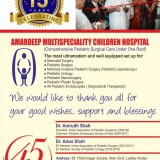INFORMATION AVAILABLE IN ENGLISH, GUJARATI AND HINDI
Meckel’s diverticulum is one of the most common congenital digestive system disorders – congenital means that the disorder was present at birth. When your child’s small intestine was developing, a small pouch formed consisting of tissue from elsewhere in the body. Usually the pouch – also known as Meckel’s diverticulum – is formed from tissue similar to that found in the pancreas or stomach.
In many cases, Meckel’s diverticulum does not cause any problems. Up to two per cent of the population will have a Meckel’sdiverticulum.
What causes Meckel’s diverticulum?
We do not really know why this pouch forms during pregnancy. The intestines form early in pregnancy as a long straight tube – before the tenth week they grow and bend to develop into the separate organs making up the digestive system. The Meckel’s diverticulum occurs at this point of bending, and is a leftover bit of development.
What are the signs and symptoms of Meckel’s diverticulum?
Many people will be unaware that they have this pouch in their small intestine as it causes no problems at all. However, in a small proportion of children, the pouch releases acid like the stomach which over time can cause ulcers to develop in the small intestine. These can worsen and bleed which shows as large amount of painless blood in the stools. It can also leak the liquid inside the small intestine into the abdomen, leading to a serious infection called peritonitis.
The pouch can also twist leading to a condition called volvulus. Twisting can cause the blood supply to the intestine to be cut off, which can be a life threatening condition. It can also fold inwards leading to a condition called intussusception. Symptoms of volvulus and intussusception can include sudden bouts of crying and pulling the legs into the body which then stop suddenly.
As little or no food or liquid can pass the twisted or blocked portion, your child may also pass little or no faeces (stools). This causes cramps, as the bowel cannot push food and liquid past the twisted section of bowel. The twisting also cuts off the blood supply to the bowel, which can lead to the tissues in the bowel becoming inflamed and starting to die.
Vomiting, especially green vomit is another symptom of volvulus and intussusception, as your child is unable to digest food as usual. If the condition is not treated, your child will become dehydrated which can be life threatening. The symptoms of dehydration may appear in phases and include lethargy, reduced urine output and dehydration.
How is Meckel’s diverticulum diagnosed?
If your child has a blockage an x-ray or ultrasound scan will be used to identify the affected part of the intestine.
Sometimes a test called a Meckel’s scan is used to show your child’s intestine and whether it contains a certain type of tissue that can cause bleeding. The scan works by injecting a substance called an isotope into your child’s veins, which then travels through the blood supply to the intestine. A series of pictures are taken while the isotope is passing through the intestine. This scan may not always identify the pouch.
Laparoscopy is diagnostic and therapeutic (curative) for Meckel’s diverticulum. This involves inserting a small telescope and camera inside your child’s abdomen. Meckel’s diverticulum may also be discovered incidentally during another procedure like an appendicectomy.
How is Meckel’s diverticulum treated?
If the Meckel’s diverticulum is causing problems, your child will need an operation to correct it. The Meckel’s diverticulum is cut at its base where it is attached to the small intestine and the defect is then closed with stiches. Some times if the base is very wide, 1 – 2 cm of the small intestine segment along with the Meckel’s diverticulum may be needed to be removed and the rest of the intestine reconnected with stiches.
What happens next?
Immediately after the operation, your child will be kept fasted so the stomach and bowel can start to heal. Once the bowel starts to work, the child can start to feed your child again, starting with small amounts, and increasing the amount as tolerated.
Outlook:
The outlook depends on how quickly the problem was diagnosed and treated as this in turn can influence the amount of damage to the bowel.
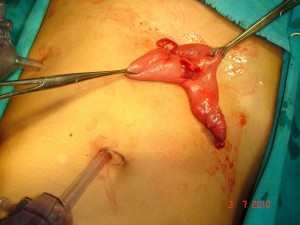 Meckel’s Diverticulum
Meckel’s Diverticulum
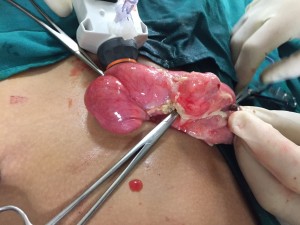 Perforation caused in Meckel’s Diverticulum
Perforation caused in Meckel’s Diverticulum
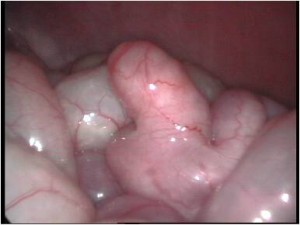 Meckel’s Diverticulum (At Laparoscopy)
Meckel’s Diverticulum (At Laparoscopy)
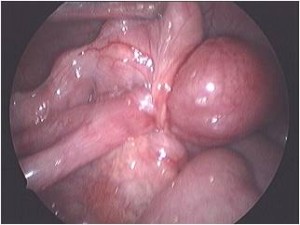 Meckel’s Diverticulum causing obstruction of intestine (At Laparoscopy)
Meckel’s Diverticulum causing obstruction of intestine (At Laparoscopy)
 Meckel’s Diverticulum (At Laparoscopy)
Meckel’s Diverticulum (At Laparoscopy)
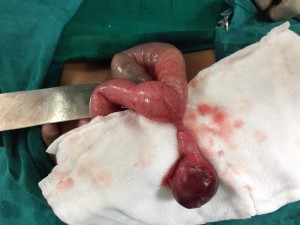 Torsion caused in Meckel’s Diverticulum
Torsion caused in Meckel’s Diverticulum
GUJARATI
મેકલ્સ ડાયવર્ટીક્યુલમ
આ આંતરડાની એક જન્મજાત ખોડ છે. જેમાં લગભગ ૨ ઈંચ જેટલું આંતરડું નાના આંતરડાના વધારાના ભાગ તરીકે મોટા આંતરડાથી લગભગ ર ફૂટ દૂર જાવામાં આવે છે. આવી ખોડ ર% જેટલાં લોકોમાં હોય છે. નાના આંતરડાનાં આ ભાગને મેકલ્સ નામના સર્જનનાં નામ પરથી “મેકલ્સ ડાયવર્ટીક્યુલમ” કહે છે.
મેકલ્સ ડાયવર્ટીક્યુલમ ઘણી બધી તકલીફો કરી શકે છે જેવી કે :
૧) ઇન્ફેક્શન થવું : એપેન્ડીસાઇટીસ જેવી બીમારી લાગે.
૨) પરફોરેશન (કાણું પડી જવું) થઈ પેટમાં ઇન્ફેક્શન કરવું.
૩) ચાંદી પડી સખત લોહી મળ માર્ગે જવુંં.
૪) આંતરડામાં બ્લોકેજ કરવું.
૫) ઇન્ટુસસેપ્શન થવું : નાનું આંતરડું મોટા આંતરડામાં જઈ ઇમરજન્સી ઊભી કરે.
નિદાન કઈ રીતે કરવુંઃ
૧) સોનોગ્રાફી અથવા સાદા એક્સ-રેમાં ખબર ન પડે.
૨) સીટી સ્કેનમાં પણ જ્વલ્લે જ ખબર પડે છે.
૩) બ્લીડીંગ થાય ત્યારે ન્યુÂક્લયર સ્ટડીથી ખબર પડે.
૪) લેપ્રોસ્કોપીથી ૧૦૦% નિદાન થાય છે. એપેન્ડીક્સના આૅપરેશન માટે કરવામાં આવતી લેપ્રોસ્કોપી દરમ્યાન આ ખોડનું નિદાન થતું હોય છે.
વારંવાર પેટનો દુઃખાવો અથવા ઉપર બતાવ્યા પ્રમાણે કોમ્પ્લીકેશન થાય તો આૅપરેશનથી જ જિંદગી બચી શકે છે. •
HINDI
मेकल्स डायवर्टीक्युलम
यह आंतों का एक जन्मजात विकार है। इसमें छोटी आंत में लगभग २” अतिरिक्त हिस्सा उभर आता है, जो बड़ी आंत से लगभग २ फीट की दूरी पर होता है। यह विकार २% लोगों में पाया जाता है। छोटी आंत के इस भाग को मेकल्स नामक सर्जन के नाम पर से “मेकल्स डायवर्टीक्युलम” कहा गया है।
मेकल्स डायवर्टीक्युलम के कारण बहुत सी समस्याएं हो सकती है, जैसाकिः-
१) संक्रमण : एपेंडीसाइटीस जैसी बीमारी दिखती है।
२) परफोरेशन (छेद का होना) के कारण पेट में संक्रमण हो सकता है।
३) आंतों में छाला होने के कारण मल मार्ग से रक्त स्त्राव हो सकता है।
४) आंतो में अवरोध पैदा हो सकता है।
५) इंटुससेप्शन होनाः छोटा आंत बड़े आंत में घुस कर आपातस्थिति उत्पन्न करता है।
निदान कैसे करें :
१) सोनोग्राफी अथवा सामान्य एक्स-रे से पता नहीं चलता।
२) सीटी स्केन में भी शायद ही नजर आता है।
३) रक्त स्त्राव होने पर न्युक्लीयर स्टडी से पता चलता है।
४) लेप्रोस्कोपी से १००% निदान होता है।
बार-बार पेट दर्द अथवा उपरोक्त जटीलताएं दिखाई दे तो ऑपरेशन द्वारा ही जान बचाई जा सकती है।•



